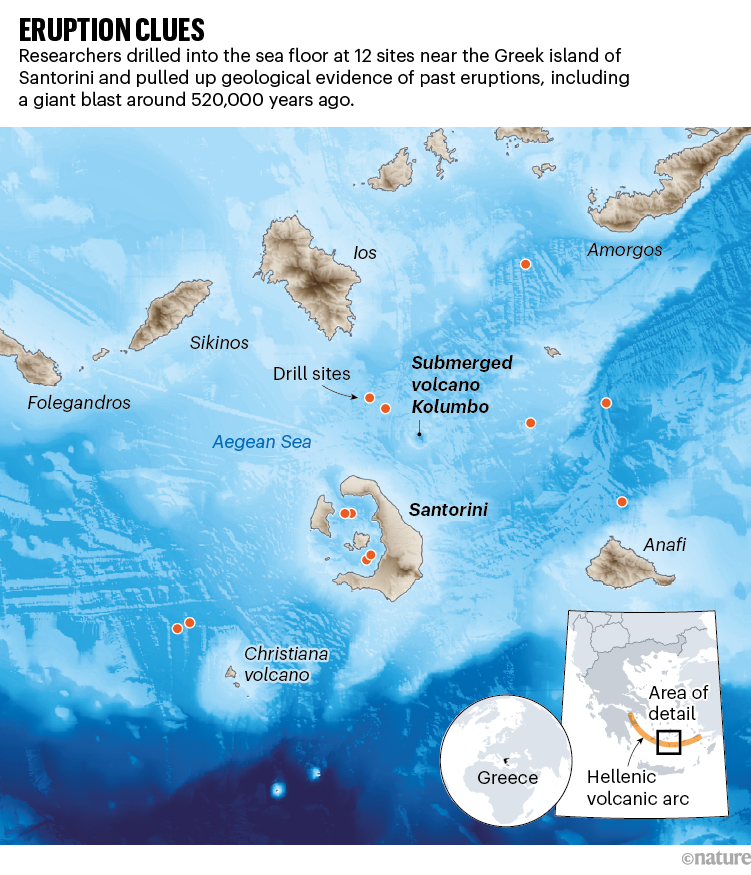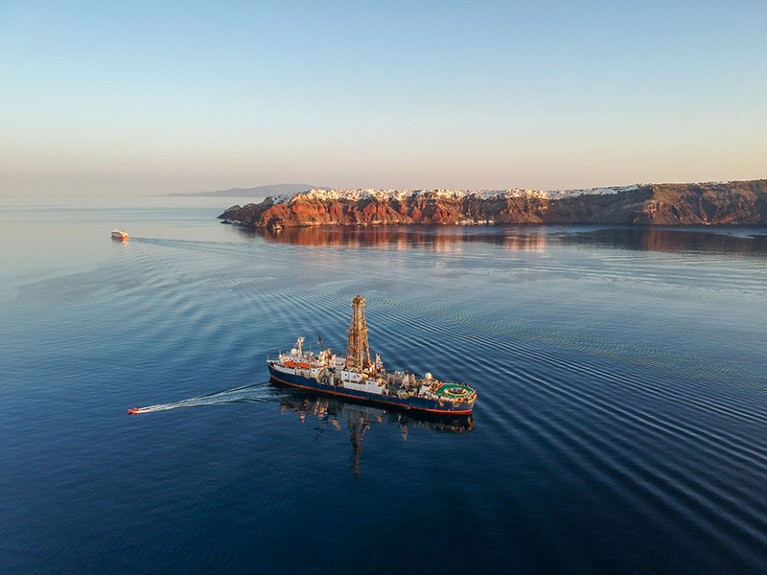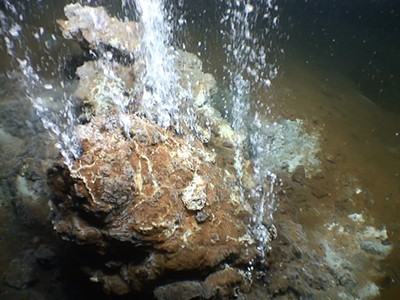One of the world’s most-studied volcanoes turns out to be hiding plenty of secrets. Geologists have unearthed major clues about past eruptions of the Greek island of Santorini by drilling into the sea floor around the partially submerged volcano.
Santorini is famous among volcanologists for its Bronze Age eruption in approximately 1600 bc, which might have contributed to the decline of the Minoan civilization on the island of Crete. Santorini is also home to more than 15,000 residents and attracts around 2 million tourists each year, who instagram their way around the white- and blue-washed buildings set against the glittering sea.
During an expedition between late 2022 and early 2023, researchers discovered evidence of a previously unknown cataclysm. Half a million years ago, the volcano erupted violently enough to blanket three nearby islands in debris, and it sent underwater currents racing for 70 kilometres. The eruption was much larger than the one in 1600 bc and was one of the biggest ever in this part of the Mediterranean.
The expedition also pulled up evidence that Santorini erupted in the year ad 726 in a blast approximately the size of Mount St Helens’ in Washington in 1980.
No one had understood the scale and scope of these eruptions until now. “The history of Santorini is being written again,” says Paraskevi Nomikou, a marine geologist at the National and Kapodistrian University of Athens in Greece, who was a researcher on the expedition.
Although scientists aren’t expecting similar eruptions to happen any time soon, the findings add to the growing understanding of the volcanic risk at Santorini, which last erupted in 1950. A related volcano, Kolumbo, lies underwater just 7 kilometres away; it last erupted in 1650 and is also considered active. Both Santorini and Kolumbo are part of the Hellenic volcanic arc, a chain of mostly underwater volcanoes that sit at the junction where the plate of Earth’s crust that carries Africa dives beneath the Aegean Sea plate.
With its explosive history and thriving tourist trade, Santorini is one of the most hazardous volcanoes in Europe. Researchers have pieced together much of its eruptive past, by gathering evidence from rocks on land and from cores that could be obtained fairly easily from the top few metres of the Mediterranean sea floor. But part of Santorini’s history is buried deep beneath the sea floor and had remained inaccessible.
That is, until the drill ship JOIDES Resolution arrived in December 2022 for a 2-month expedition; the researchers drilled 12 holes into the sea floor and pulled up long cores of sediment and rock in and around Santorini and Kolumbo (see ‘Eruption clues’). “By going into the marine realm we can go further back in time,” says Timothy Druitt, a volcanologist at the University of Clermont Auvergne in Clermont-Ferrand, France, and co-chief scientist of the expedition.

Sources: Elevation: NASA; Bathymetry: EMODnet
The drilling around Santorini wasn’t easy; several of the drill holes collapsed in a slurry of pumice and ash, which glommed onto drilling equipment like superglue. At one point, on New Year’s Eve, technicians had to sever the pipe used for drilling, leaving some of it in the hole.
The many drilling challenges meant that “we had several days where we were just sitting there not knowing what to expect for the next days”, says Steffen Kutterolf, a volcanologist at the GEOMAR Helmholtz Centre for Ocean Research in Kiel, Germany, and the expedition’s other co-chief scientist. But ultimately, the team extracted an unprecedented data set about the region’s volcanic past.
Some of that volcanic past involved submarine eruptions, in which most of the volcanic debris never reaches above the ocean surface. Learning about these eruptions is important because they can be powerful and are poorly understood: in January 2022, an underwater volcano exploded near Tonga in the most violent eruption in decades, yet nearly all of the evidence that it happened remains beneath the waves.
Among the most significant discoveries at Santorini was a thick layer of the volcanic rock called tuff, which kept appearing in core after core, created by a huge prehistoric eruption. “Slowly it began to dawn on us that this was a major [geological] unit we didn’t know anything about,” says Druitt. The researchers named it the Archaeos tuff, after the Greek word for ‘ancient’. It formed around 520,000 years ago when Santorini erupted underwater, sending shards of ash and rock racing outwards like giant avalanches, the team reported in January in Communications Earth & Environment1.
As measured by the size of those underwater flows, the eruption was 6 times larger than the 1600 bc eruption at Santorini and 10 times larger than the 2022 Tonga eruption. But Druitt says not to worry about such an ancient eruption: “There’s absolutely no reason to think that Santorini is going to do anything like this in the near future.”
More relevant to modern hazards is the discovery of how big the eruption in ad 726 was. Historical accounts relate that “the sea was seen to boil” that year, and that large blocks of pumice — lightweight rocks that often form during underwater eruptions — floated to the surface and travelled for hundreds of kilometres. But researchers had little information about the scale and nature of the eruption, Jonas Preine, a marine geophysicist at the University of Hamburg in Germany, said in December at a meeting of the American Geophysical Union in San Francisco. With the JOIDES Resolution, he said, the team aimed to “solve a historic mystery and find a lost eruption”.

The JOIDES Resolution drill ship in Santorini.Credit: Thomas Ronge/IODP
The researchers did this by comparing rocks drilled during the expedition with information about the layering in the rocks beneath Santorini that comes from studies of seismic waves passing beneath the island. Preine and his colleagues concluded that they had indeed found widespread evidence of an eruption in ad 7262.
“The 726 eruption has always been used as a worst-case scenario” for a modern eruption at Santorini, says Druitt. “What’s interesting is, the worst-case scenario has just increased in magnitude quite a lot.” Among other things, Preine’s team found that the material from the ad 726 eruption is crumbly, meaning that a future eruption could destabilize that layer and lead to greater chances of underwater landslides, which could trigger tsunamis.
The ocean-drilling expedition has added important chapters to the scientific understanding of Santorini, says Emilie Hooft, a geophysicist at the University of Oregon in Eugene, who did not go on the expedition but who has been working to map the magma chambers beneath Santorini and Kolumbo3. “The history of the volcano was perceived to be so well known from all the work that was done on land,” she says. And yet “there’s actually a lot to be discovered about the interaction with the eruptive system and the marine environment” — such as how those crumbly layers formed during the underwater eruption in ad 726.
Greek authorities regularly monitor geological activity at Santorini, by tracking earthquakes, movement of the ground and other changes. The JOIDES Resolution expedition was a high-profile chance to inform residents about the volcano’s hazards, says Nomikou, who was born and raised on the island. She gave talks and virtual tours to school groups about how researchers are monitoring Santorini and neighbouring volcanoes. “There is no need for panic,” she says.

Underwater volcano near Greece is a sleeping menace
Although magma continues to pool beneath Santorini, it also leaks out in minor eruptions such as those in the 1920s through to the 1940s that created small lava flows on uninhabited islands. The magma leakage takes some of the pressure off the system, Druitt says. Still, in 2011 and 2012, a months-long period of small earthquakes and ground shifts rattled Santorini, frightening the public and triggering emergency authorities to research evacuation scenarios. And the growing understanding of the threat of submarine eruptions means that researchers need to keep a particular eye on Kolumbo. Its crater floor is around 500 metres below sea level but the rim is around 20 metres beneath the waves.
Kolumbo’s last eruption, in 1650, generated poisonous gases that killed around 70 people and many animals on Santorini. But Kolumbo is now monitored better than ever; over the past year, Nomikou has led an effort to install geochemical, seismic and other instruments on the sea floor around the volcano4. Early results show that Kolumbo has more than 300 active volcanic chimneys that spew carbon dioxide into the surrounding waters.
“It’s a very toxic environment,” says Nomikou. And that’s why she spends so much time educating people on Santorini about its unique risks: “They need to know that they are living in an active volcano.”
